VFC-13 Fighting Saints: “Training the Fleet Air Wings”
Report and photos by Patrick Roegies, Paul Gross and Marco Dijkshoorn
January 14, 2018
Introduction
The United States Navy (USN) Carrier Air Wings are continuously improving their operational readiness skills and tactics. By submitting the aircrews of the Carrier Air Wings to adversary training during a workup cycle the crews are able to further develop their skills in real time scenario using the adversary capacity within the US Navy. This adversary training takes place during a four week period in which twice a day missions are conducted creating a real time adversary scenario.
Adversary Navy squadrons
The USN operates a total of three reserve adversary squadrons (VFA-111, VFA-12, VFC-13) while the United States Marine Corps (USMC) operates one reserve adversary squadron (VMFA-401). These squadrons consist of F-5N and F/A-18 aircraft. The Navy has an additional reserve strike fighter squadron (VFA-204) that also operates as an adversary squadron utilizing their FA-18s. The FA-18s and F-16’s assigned to the Naval Air Warfare Development Center (NAWDC) are also used primarily as aggressors providing additional adversary assets to USN aviators.
VFC-111 based at NAS Key West primarily provides adversary support in simulated fighter combat as well as multiple aircraft strike exercises. This squadron mainly provides adversary support to the relative new pilots that are trained on the F/A-18 Hornet in the two Fleet Replacement Squadrons (FRS) also referred to as RAG squadrons VFA-106 “Gladiators” at the East Coast and VFA-122 “Flying Eagles” on the West Coast. The Key West based VFC-111 “Sundowners” squadron is equipped with the F-5N and provides dissimilar air combat training.
The United States Navy Reserve strike fighter squadron VFA-204 “River Rattlers” based at Naval Air Station Joint Reserve Base New Orleans is a Naval Air Reserve Force (COMNAVAIRESFOR) squadron and is equipped with the F/A-18A+ Hornet provides and supplements the same service by sending both personnel and aircraft to both NAS Key West and NAS Fallon.
Another East Coast based adversary squadron VFC-12 “Fighting Omars” subordinated to COMNAVAIRESFOR) also operates the F/A-18A+ Hornet. The primary task of this squadron is to provide adversary training to the Strike Fighter Advanced Readiness Program (SFARP), responsible for training operational fleet F/A-18 Hornet squadrons. Equal to VFA-204 the “Fighting Omars” of VFC-12 supports the F/A-18 Fleet Replacement Squadrons at NAS Oceana is often detached to NAS Key West.
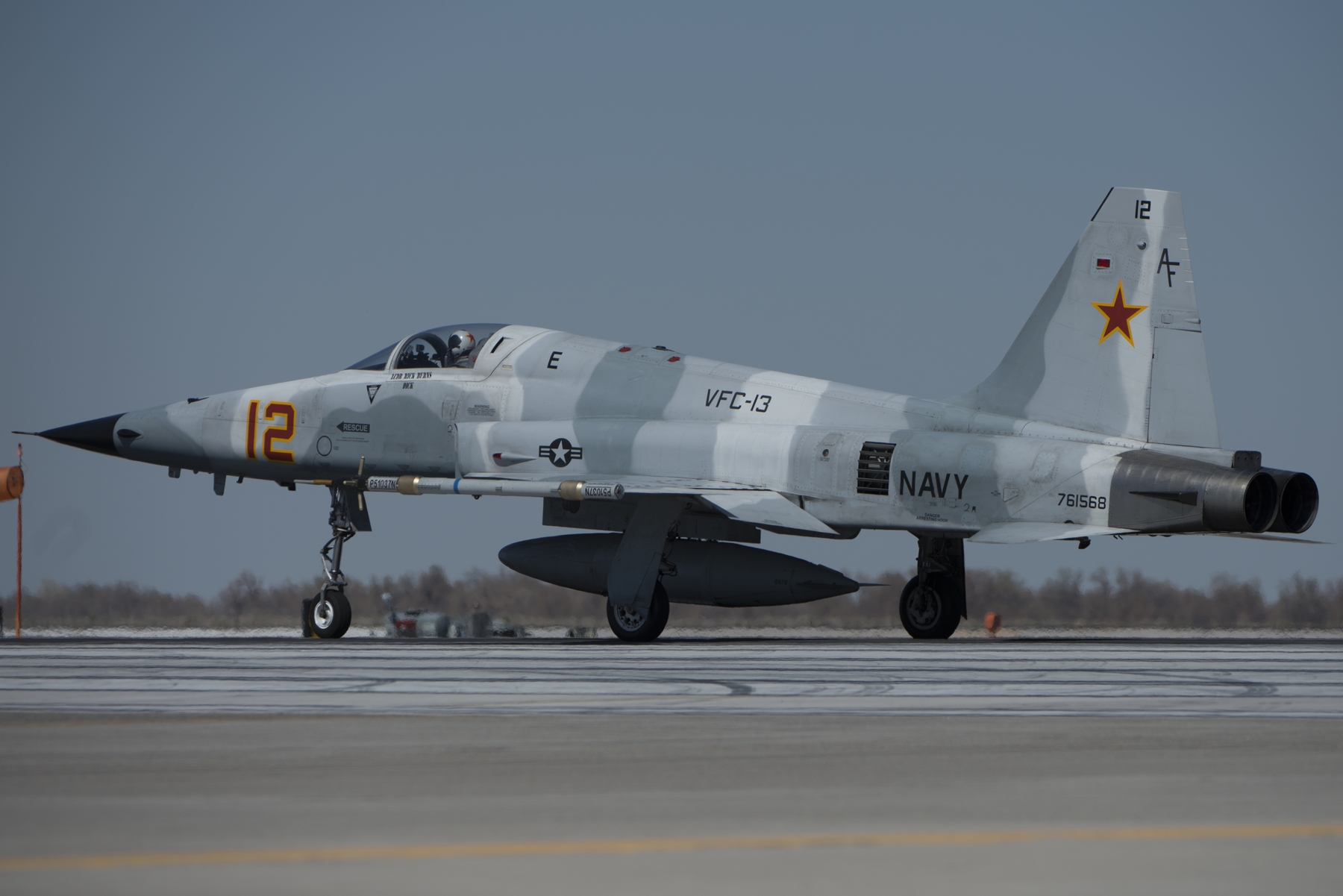
The “Fighting Saints” of VFC-13 are based at NAS Fallon and are the current program manager of the F-5N within the Navy. The squadron’s present-day mission includes support locations from coast to coast, in fulfillment of professional Fleet adversary support. The “Saints” primarily provide Adversary support for Fleet Replacement Squadrons, Carrier Air Wings, the Strike Fighter Advanced Readiness Programs (SFARP), and Navy Special Warfare training. With the formation of VFC-111 the tasks of training the FRS squadrons have been transferred to VFC-111. The squadron cooperates with assets from NAWDC and assets from VFA-204 and VFC-12 in order to perform their specified tasks. The squadron also provides dissimilar air combat training for the Top Gun classes that are organized at NAS Fallon.
VFC-13 used to have a regular detachment at NAS Key West until the Navy decided to reform the former VF-111 “Sundowner” squadron to VFC-111 operating the F-5N in the adversary role. In this way VFC-13 was able to specialize in the SFARP training and VFC-111 could focus on the FRS or RAG training. FRS training differs from SFARP training since the FRS pilots are mainly pilots either just completing of in the process of completing their pilot training prior to be integrated in an actual strike fighter squadron. The location at NAS Key West provides the possibility to conduct supersonic missions over the water, but limits the training presentation possibilities since there are no mountains to hide behind.
Saints history
VFC-13 has a proud and rich tradition in the history of naval aviation and fleet support. The squadron formed in 1973 as VC-13 was equipped with F-8H Crusaders and developed into the present adversary mission operating the former ex-Swiss Air Force F-5N Tiger II, the “Saints” have exemplified pride, professionalism and safety in all endeavors.
VC-13 was formed on 1 September 1973 at NAS New Orleans during a reorganization of the Naval Reserve. Initially, the squadron operated the F-8H Crusader, all former members of VSF-76 and VSF-86. In April 1974, the “Saints” transitioned to the single-seat A-4L Skyhawk. As the demand for west coast fleet support missions increased, the squadron moved to NAS Miramar, California in February 1976 and transitioned to the more reliable two-seat TA-4J. During 1983 single-seat aircraft returned to VC-13 with the arrival of the A-4E.

VC-13 was proudly re-designated as Fighter Squadron Composite Thirteen (VFC-13) on 22 April 1988, in recognition of the squadron’s evolving mission. At that time the “Saints” logo was redesigned to reflect the more focused role of fleet adversary support. The new logo displays the wings worn by the highest classification of the former Soviet Union fighter pilot, the “Sniper”. In 1988, the Saints transitioned to the A-4F Super Fox, a more powerful and capable version of the “Skyhawk” and in October 1993, VFC-13 transitioned to the single-seat, twin engine F/A-18 Hornet. In 1995 the “Saints” received the 1994 CNO Safety “S”, Carrier Air Wing Twenty Reserve Golden Wrench award and Noel Davis Trophy (Battle “E”), which earned the squadron the right to proudly display the “S”, “M”, and “E” on the sides of their aircraft.
Budget cuts associated with post-Cold War “right-sizing” of the Navy resulted in the squadron transitioning to the F-5E/F Tiger II and relocating to NAS Fallon, Nevada in March of 1996. NAS Fallon, the “Saints'” current home, is the primary location for all Navy carrier-based tactical aircrew training. VFC-13 Adversary pilots work closely with the Naval Air Warfighting Development Center (NAWDC) to provide the best air combat training possible. From 2008 onwards the F-5E models have been replaced by ex – Swiss Air Force acquired F-5N aircraft.
The “Saints” are manned with 43 navy personnel including 17 enlisted and 26 officers. The 17 enlisted personnel are a select group of dedicated professionals who provide critical operations, administrative, safety and training support to the squadron. Maintenance of the squadron’s F-5Ns is performed by civilian contractors employed by Pacific Architects and Engineers (PAE). The 26 member officer corps includes 14 Selected Reserve (SELRES), 6 Regular Navy and 6 Full Time Support (FTS) officers. These three elements of the “Saints” team combine to fly over 3,500 Adversary sorties per year.
Strike Fighter Advanced Readiness Programs
The Strike Fighter Advanced Readiness Programs (SFARP) are mainly conducted at NAS Fallon also referred to as work ups for a future deloyment on an aircraft carrier. Two different training programs can be identified. There is a basic workup program and a larger force exercise workup preparing the Carrier Air Wing for an actual cruise.
Every Carrier Air Wing will pass through NAS Fallon during their work-up period. During a three week deployment of the Carrier Air Wing at NAS Fallon the air crews are submitted to an intensive training that enables the Strike Fighter Wing air crews to improve their fighting skills against a realistic and creditable adversary component prior deployment on their next cruise. During this three week training VFC-13 closely cooperates with the adversary assets appointed to the Naval Aviation Warfighting Development Center (NAWDC) also based at NAS Fallon.
The “Fighting Saints” provide a formidable dissimilar adversary threat presentation. In order to prepare the fleet Carrier Air Wings the Navy uses the adversary squadrons in order to meet and defeat the threats during an upcoming deployment. The area surrounding NAS Fallon is extremely suitable for this type of training since it comprises an area of approximately 70 by 150 miles that is indicated as a no fly zone for commercial aircraft and is the ideal location for adversary training. The range includes several bombing practice ranges enable the participants to practice any scenario in real time. This area includes certain areas over Lake Tahoe and the Sierra Nevada which presents a very wide variety of landscapes. The surroundings present an ideal scenery for the small and agile F-5’s to hide in and present the aircraft integrated in the carrier air wing an as real as possible scenario. With a minimal specified altitude during the different combat training sorties at low level the F-5 is able to exploit its agility to the maximum.

The primary task of VFC-13 is providing an as real possible scenario for the participating aircraft during a sortie. In order to do that VFC-13 cooperates with the assets from NAWDC which are mainly F-16s and also F/A-18s. Together they act as “Red Air” operating against the aircraft of the Carrier Air Wing “Blue Air”.
During a typical sortie the aircraft from the Carrier Air Wing launch and fly to the most northern area of the range. The adversary aircraft launch during or immediately after the aircraft from “Blue Air” are launched. Although the aircraft assigned to “Blue Air” are more advanced and do have the disposal of an E-2 early warning aircraft, the aircraft from “Red Air” still present a real time training partner. The pilots of “Red Air” have several big advantages Lt. Matthew Gottschalk explains. The first advantage is that the adversary crews know the terrain and know where to hide the agile F-5s and F-16s which is clear advantage operating at low level since it makes the aircraft difficult to spot. By knowing the terrain communicating their location using landmarks and nicknames makes situational awareness easier as well. Secondary the adversary aircraft operating at low level are all painted in a terrain suitable camouflage. The aircraft operating on high altitude are painted in a multiple tone blue camouflage. The aircraft appointed to “Blue Air” have to operate their specific mission fighting their way through the “Red Air” assets.
During the three week deployment of a carrier air wing the daily missions develop with an increased difficulty level. With the air wing work up deployment at full swing sorties can last up to 3 hours presenting “Blue Air” with several real time threats both on the way in and out, in which the air wing is presented with both low level and high level attacks, including early warning and electronic warfare capabilities. Prior to every sortie a pre-flight briefing is provided by a representative of the adversaries to the blue air squadrons, providing them to prepare as well as possible flight plan. After the sortie the entire mission is briefed providing the air crews of “Blue Air” to evaluate and improve their skills.
Red training blue
Every Carrier Air Wing designated as “Blue Air” use their own tactics. The tactics used during a daily mission are all preplanned and briefed to explain what is going to happen and how the aircrews of blue air should react when the event occurs. Lt. Matthew Gottschalk comments that all participants of both “Blue air” and “Red Air” joining the daily mission are all using the same frequencies, meaning we’re all briefed on what’s going to happen during that specific sortie, in order to provide and meet the appropriate training objectives by presenting realistic situations. Diverting from those tactics might degrade the training program. The adversary squadron can decide on how to step up the difficulty level of the training program as they proceed in accordance with the requirements of the “Blue Air” squadrons.
Usually when a Carrier Air Wing arrives they basically start with a “prowl, walk, run mentality” which is not very difficult and gets the aircrews familiarized with the territory and the basic rules of engagement. As the Carrier air wing proceeds through their three week training the difficulty level ramps up and develop to that point where they should be able to handle a large variety of situations that might occur during actual air combat missions. Since the pilots in the squadron vary from experienced pilots to newcomers that do not have a whole lot of experience this familiarization phase will allow these fresher aircrews to pick up the pass at an easier level and gets more complex as the progress. By using the assets of NAWDC such as E-2 early warning capabilities and EA-18 growler capabilities allows “Red Air” to increase the difficulty level in which “Blue air” is confronted with “jamming” and starting to see different complex scenario’s, where aircrews are confronted by adversaries that are hung up behind mountains or fly beneath them as they progress their training.
Initially these training missions take place during day-time but as the program proceeds the same scenarios are trained during night-time missions. Since VFC-13 does not operate using night vision goggles the low level training missions are exclusively conducted during day time mission.
Ultimate training assets
Although there are occasions where “Red Air” defeats “Blue Air, winning is not the goal of the adversary squadron. On one hand it is a great accomplishment since it proves that “Red Air” is challenging the “Blue Air” participants so as not to give them an easy ride. The main purpose of “red air” is always to test the “blue air”, and try to determine what was performed well and what was performed incorrectly by the blue air. In this event somewhere there is a breakdown whether it is in the radar mechanics, the ability, the air traffic control responsible operator in the E-2 that did not inform the aircrew about the presence of the “Red Air” threat in time or any other cause that has to be clarified and evaluated after the mission in order to improve the blue air crews and entire carrier air wing teams skills, since this is a situation that should not happen Lt. Gottschalk comments that “although it is not gratifying to win “Red Air” participants however pull all stops in order to train the “Blue Air” squadrons in order to make them better”.
One would expect the capabilities of “Blue Air” are much more advanced than the capabilities of “Red Air” providing “Blue Air” with a clear advantage. On paper that is a correct assumption, but there are a few factors to be taken into account. The tactics used by “Red Air” once they arrive at their designated position during their daily mission can be executed in a very familiar environment which is actually similar to the situation to what any actual threat nation is expected to do in real life situations. That is where “Red Air” tactics are based upon. If there is an event where situations or events are happening during the adversary training it is likely they could happen during an actual combat mission. There is ground assistance to where the aircraft are, and “Red Air” is very familiar with the territory. This situation is also applicable for the aircrews of VFC-13 and NAWDC that exactly know the territory and can communicate by specifying locations in a different terminology that are unknown to the “Blue Air” crews.
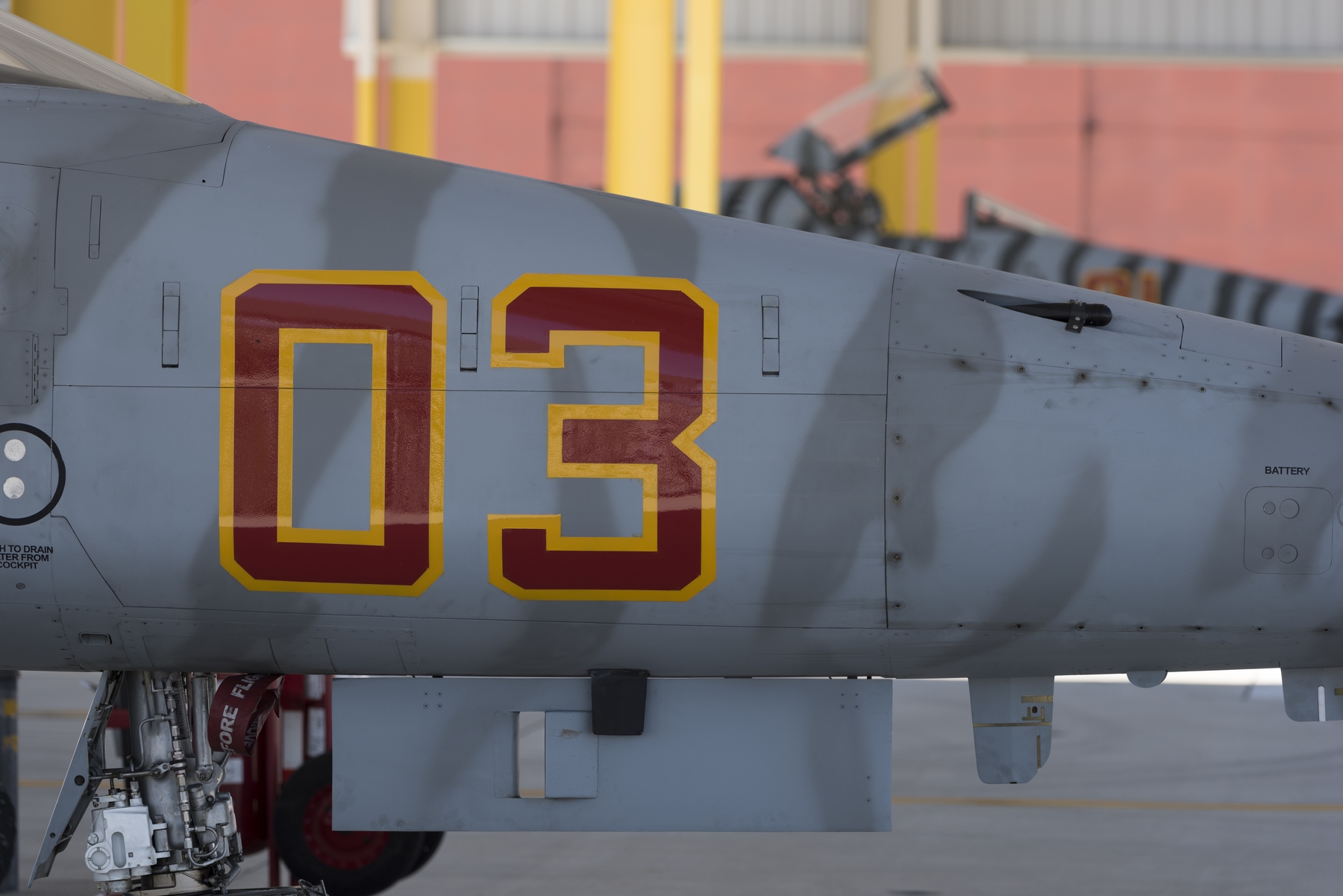
The second advantage is the agility and applied camouflage of the F-5N aircraft that allows the aircraft to hide itself at low altitude, making the virtually invisible in the terrain, or at least hard to spot for the participants of “Blue Air”.
The third advantage is the use of the NAWDC capabilities enabling “Red Air” to bring enhanced capabilities to the fight. The increased speed and duration of operational combat time in the area of operations and the possibility to present a threat at higher altitudes. The E-2 Hawkeye aircraft assigned to NAWDC can present a real life picture of the actual locations of the “Blue Air” assets to the “Red Air” adversaries and the NAWDC EA-18 Growlers can even jam the radar systems of the “Blue Air” Assets. This entire presentation will reflect a realistic simulation of a real life threat situation and proves to be a very efficient way to prepare the Carrier Air Wings for their future deployments.
A typical day at the office
Each day during the three week training course will start with a mission coordination briefing. The overall lead will brief “Blue Air” and is performed on a daily basis to ensure everyone is on the same page. This is a coordination brief and will provide information concerning the radio frequencies in use during the daily mission, the used air space, the daily weather conditions and last but not least the daily training rules, which are the specific safety rules. These training rules should not be violated at any time. This part of the briefing will mainly be the same during the duration of the three week training but might vary in details depending on day time or night time missions.
Once the coordination briefing is completed the overall lead will ask “Blue Air” the preferences of the aircrews in order to generate a plan that will reach the specific training requirement demands.
The overall lead then returns to “Red Air” and determines the plan to be executed by red air during that specific mission, which is a regular flight brief taking approx. 20 minutes.
Upon completion of the briefing all assets take off at the specific time in order to perform their specified sortie. Although an average mission takes approx. 20 minutes the entire sortie will take approx. an hour to get the jets airborne and in the correct position. During the flight all information is gathered and collected and all shots are recorded. Upon completion of the mission all participants are de-conflicted prior to their return to home base.

Upon return at their home base “Red Air” participants are debriefed by means of an overall debrief where all the information and experiences during that mission are discussed. During this evaluation “Red Air” will assess the information and attend to a mass debrief with “Blue Air”, which is coordinated by “Blue Air”. During that debrief a display presents all available information, recordings and movies of the mission in order to evaluate that specific mission. Representatives of “Red Air” are present during this debrief to answer any questions or comments “Blue Air” might raise on situations that have occurred in order to follow up on any shots that were taken, any mission discrepancies, any training rule violation and is meant to keep anybody on the same page concerning the completed mission, and to evaluate if the training objectives were met. This entire evolution could take up to seven hours even though the actual fight could be limited to only twenty minutes.
The available time of a specific mission can last somewhere between twenty minutes until three hours. The fuel load however of an F-5 is sufficient to keep the aircraft within that area varying from twenty minutes up to an hour depending on the fuel consumption required for the sortie depending on the application of the afterburner.
With some of the training events lasting three hours means that “Red Air” launces several waves into the area of operations and rotating jets in and out in order to present one complete scenario.
Since VFC-13 performs the role of “the bandits” it is their overall responsibility to ensure that this all happens expeditiously and in a safe manner because they are the ones who are the keepers of the safety rules and since they have the experience of doing this every single day.
Keeping up with developments
In a continuously changing world with developing technology the tactics used by possible future adversaries develop as well. This means that the adversary squadrons are continuously studying in order to “keep up” with the latest developments and adapt their “Red Air” tactics.

With the arrival of the next generation fighters it is difficult to keep up since the assets of VFC-13 do not have the required capabilities. Because the F-5N aircraft in the inventory of the “Fighting Saints” has its limitations it means that if they have to go up against the latest generation fighters the squadron is unable to replicate that situation since the performance and capabilities on avionics are limited on offensive or defensive systems. Lt. Matthew Gottschalk comments: “The pilots are very experienced and know how to exploit the F-5 to the maximum and bring this to the fight, but you can’t take an F-5 and replicate the F-35 in the same way”. The squadron has been operating the F-5 for a long time now and has proven to be a suitable platform, but recent technological developments might be a reason to replace the F-5 in the future for a type of aircraft that is able to replicate these developed performance and capabilities in order to perform the adversary role as realistic as possible. The Air Force has replaced the F-5’s in the past for more modern F-16 and F-15 fighters in order to adapt. Possibly the Navy might follow this example and possibly integrate the Super Hornets into the adversary role as well in the future in order to replicate an as realistic as possible scenario during training. Lt. Matthew Gottschalk further explains that he personally desires an upgrade to the F-16. Not from an available systems standpoint, but the F-16 has an increased on station time of fuel that allows the squadron to stay in the actual training zone for an extended time. Besides that the F-16 is still hard to see and they are really fast. There are F-16’s from NAWDC present at NAS Fallon and aircrews from VFC-13 are qualified to operate the F-16 and occasionally use the F-16 to perform their missions. He further states that the US Navy recognized the need for a future modernization but has not affected into actual plans for replacements.
Expanding adversary assets
Several sources speculate on future expansion on adversary capabilities. These speculations include the discussion on what to do with Navy Adversary squadrons. The existing squadrons are established for a while now and there are no plans to form additional squadrons or to deactivate any of the existing squadrons. There is no difference between fighting civil contractors or actual Navy squadrons and currently the contractors are mainly used to supplement the existing Navy capabilities. These contractors also use different aircraft types like the Hunter, L-39 Kfir and in the near future the Mirage F1. Since the contractors will also execute their mission using the same presentation as the Navy adversary squadrons, the sole difference is the guy in the cockpit and the dissimilar air combat capability of the aircraft used. “Blue Air” aircrews experience something different than an F-18 as their opponent.
A recent publication concerning de US Marine Corps adversary capabilities states the USMC is planning to expand their capabilities and to set up F-5 detachments at three other bases in addition to VMFT-101 “Sharpshooters”. In addition to the existing training capabilities, the USMC master aviation plan calls for adding light attack turboprop aircraft to its tactical training fleet, such as the AT-6C Coyote or A-29 Super Tucano.
The USMC F-5 fleet requirements have grown significantly the past years and the gap is growing increasingly.
External adversary capabilities
Civil contractors, supplement the assets the Naval squadrons have. The external contractors do not do anything different and use exactly the same presentation.
The number of external contractors is slowly increasing and currently there are three external contractors providing their services to the Air Force, Navy and Marines. These companies are Draken Air, TacAir and Airborne Tactical Advantage Company (ATAC ). A recent publication concerning ATAC reveals that the company is expanding its capabilities and has recently acquired a batch of ex-French Air Force Mirage F1 fourth generation fighters in order to close the gap between the new fifth generation fighters currently integrated in the operational fighter squadrons and the adversary squadrons. It further stipulates that ATAC currently has a contract to supply a total of 5000 hours of adversary training. It mentions as well that the US Navy demanded a total of 5000 hours for the next year of adversary training of fourth-generation “Red Force” capability alone and the Air Force might even reserve a total of 37.000 hours.
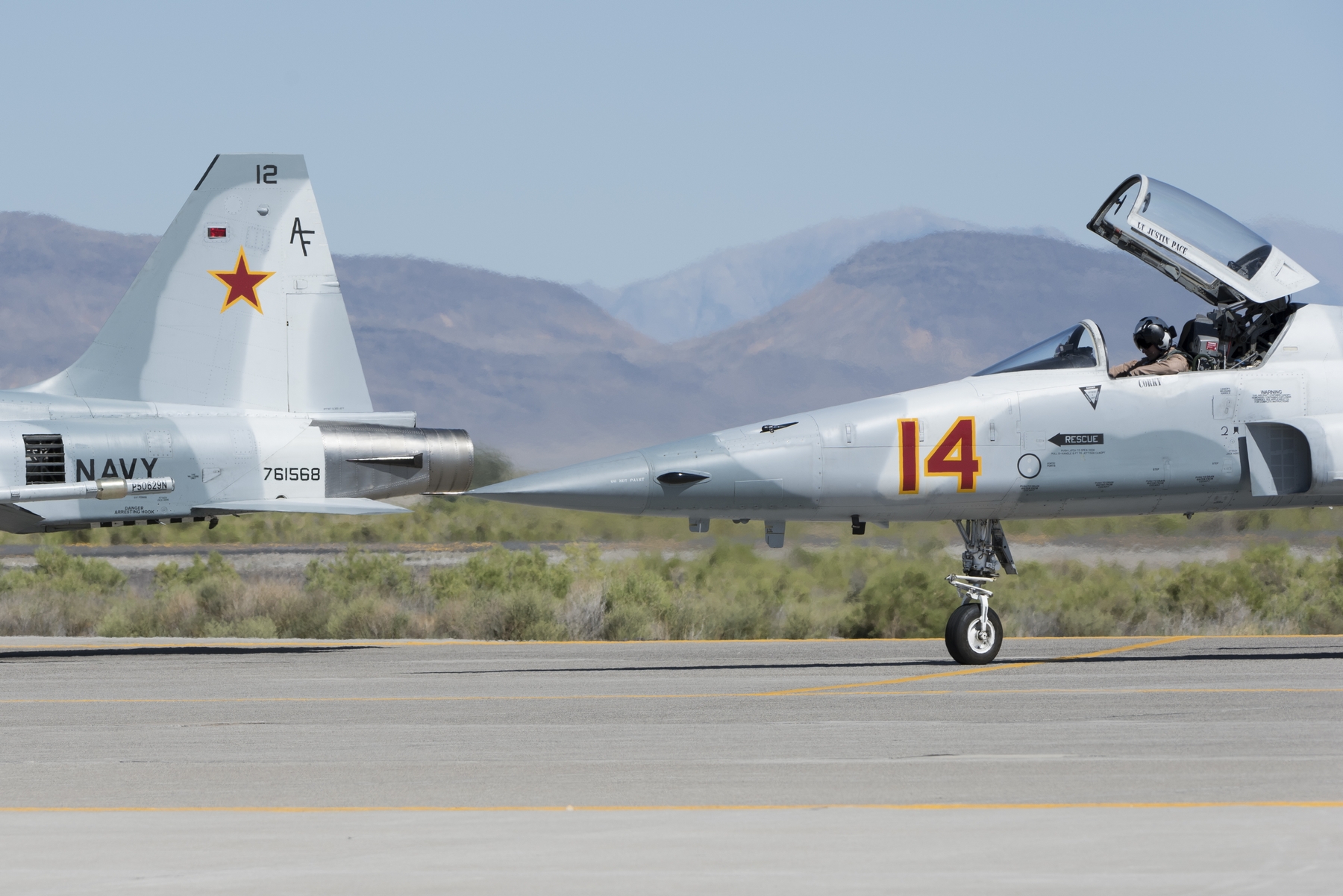
The F-5 fleet assigned to the US Marine Corps (USMC) currently meets the required readiness goals while supporting as many MAGTF adversary commitments as possible based on limited capacity. Both USN and USMC adversary requirements have grown significantly over the past decade preparing the aircrews of the Strike fighter squadrons for actual combat operations. With the increasing demand of adversary training capacity the gap is growing, with VFA-101 “Grim Reapers” and VFA-125 “Buccaneers” operational as Fleet replacement squadrons within the USN and VMFAT-501 “Warlords” and VMFAT-502 to be formed in 2019 as the Fleet Replacement Squadron of the USMC including two operational USMC squadrons VMFAT(AW)-121 “Green Knights” and VMA-211 “Wake Island Defenders” the demand for adversary capacity is expected to increase even further. With the F-35B currently being delivered to more operational squadrons, and the establishment of a “graduate level” tactics course tailored to the legacy Hornet community within the USMC , the demand for the F-5s services has skyrocketed even higher. The gap in adversary requirement can either be closed by acquiring additional F-5 aircraft or by acquiring additional fourth generation fighters either integrated in their own squadrons.
The USN and USMC aviation plan to keep the F-5 operational until at least 2025 and with a reduced number until 2028 in support of fleet training. Fourth generation presentation requirement cannot be outsourced to the private sector entirely but no actual plans have been presented to replace the F-5s by fourth generation fighters.



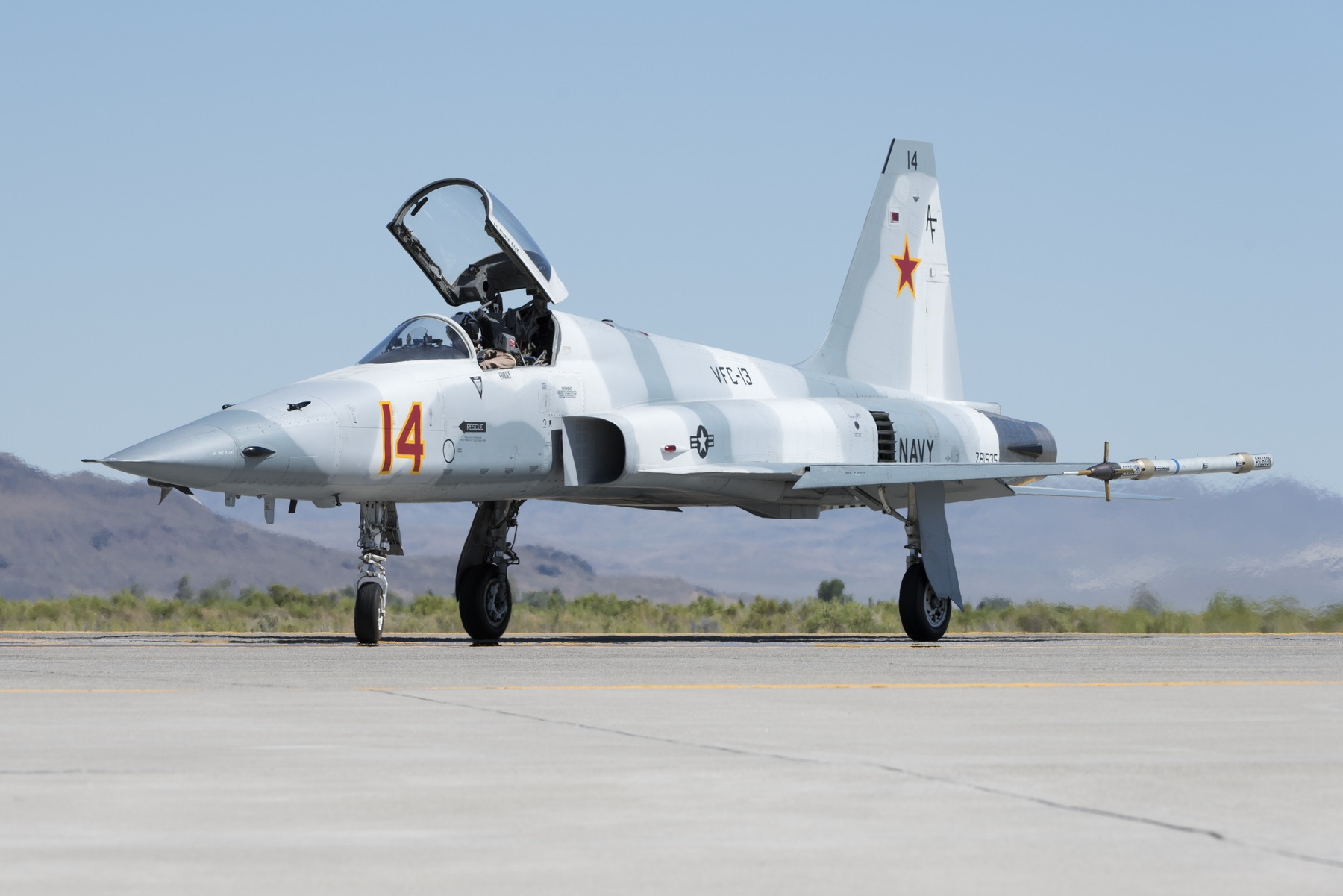












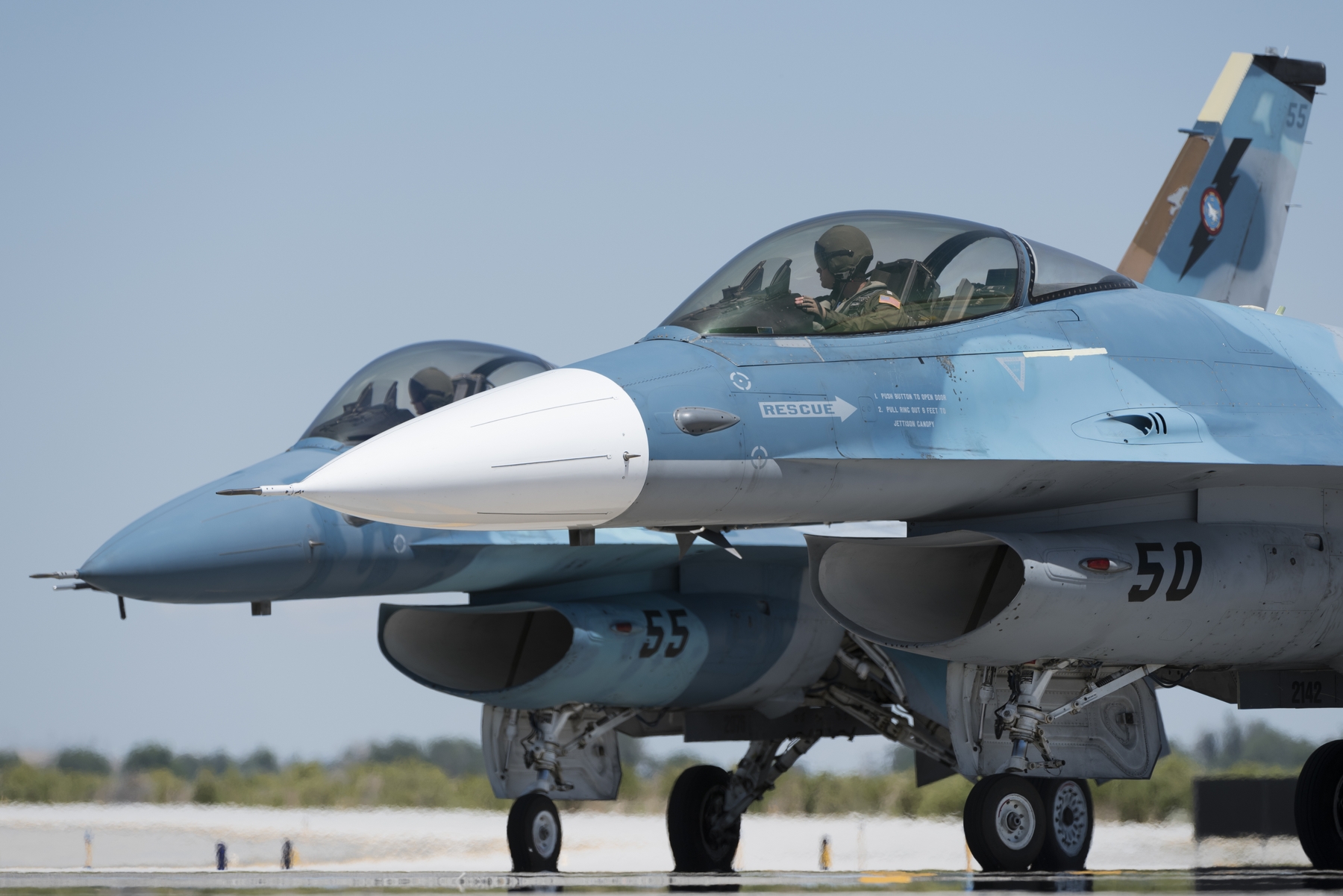
Click on an image below to page or swipe through the gallery:
Patrick Roegies is born and raised in Tilburg, the Netherlands and currently resides in Sittard in the south of the Netherlands where he lives with his wife Joyce. Patrick graduated from a technical study at the HTS in Tilburg in 1997. He currently works as a head of an equipment engineering department in the south of the Netherlands.
His passion towards aviation started at the age of 7 in 1977 when his father took him to nearby Gilze Rijen Air Force base where he witnessed his first howling F-104 Starfighters which were practicing and as a result he got addicted immediately. The F-104’s were present in order to determine a tactic to create a diversion for the “train highjack” which was going on in the Netherlands at that time. The F-104’s were meant to create a diversion by performing an overshoot, kicking in the afterburner directly over the train, creating confusion with the hijackers and enabling the police to master the hijackers. This action has actually been performed and worked.
This is when his passion towards aviation was born. He got permission from his parents to visit the airbase every free hour he had and his father showed him the way by bicycle. Patrick got his first camera in 1984 which was a Canon T50 and shot Kodachrome 64 slides of mainly military aircraft. He changed his gear in the mid-nineties to Nikon and is a Nikon user ever since.
When Patrick obtained his driver license in 1989 he started to visit airbases all over Europe and from 1997 onwards he made worldwide visits to military airbases.
In order to further professionalize his work as an aviation photographer and journalist he started to write military aviation related articles based upon his visits to various nations and their Air Forces. He managed to publish his first article in 2003 and increased the numbers of publications every year.
Patrick can be reached at: [email protected]


